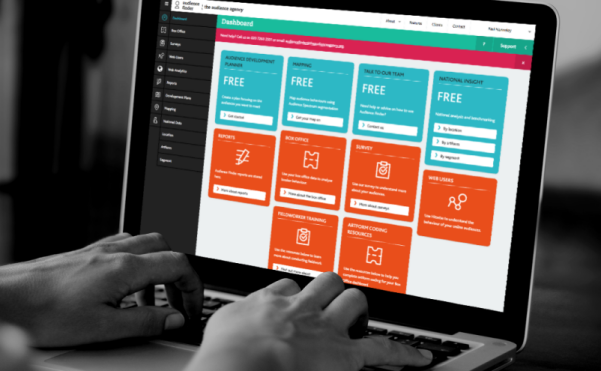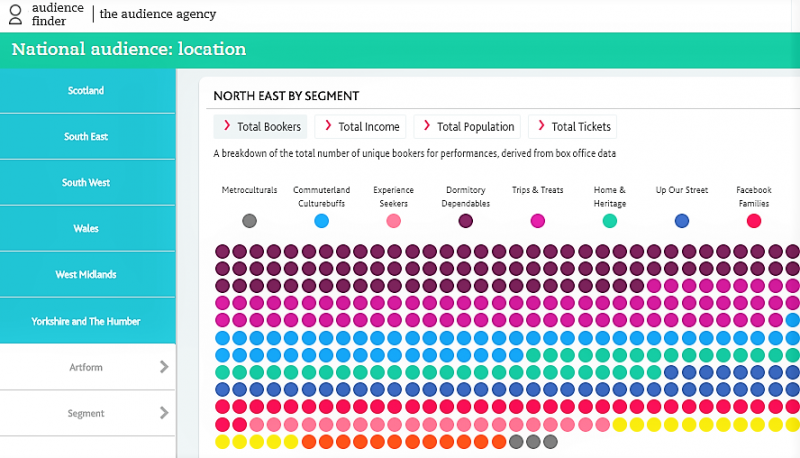
Photo: Uxblondon
Audience Finder: What’s new?
On the brink of the new funding year, Anne Torreggiani takes a whistle-stop tour of the improvements The Audience Agency is making to Audience Finder, to better meet the needs of its users.
As a sector support organisation (SSO) funded by Arts Council England (ACE), The Audience Agency will continue to offer Audience Finder from this April. We usually use our column here to tell you about the new things we’re learning about audiences, but as Audience Finder receives one of the largest SSO awards, it seems important to share news about the kind of support the sector can now expect.
The recent ‘Culture Is Digital’ report recognised that “Free national online tools such as the Audience Agency’s Audience Finder enable cultural organisations to understand, compare and apply audience insight so that they can create with audiences in mind”.
There is a heavy emphasis on helping organisations put findings into practice… growing a particular audience, spotting revenue opportunities, planning intelligent collaboration
It encourages more organisations to share and use data, particularly where its integrated scope enables broader insight and application. This thinking drives a lot of the innovations planned for the 2018-22 period, although the spotlight is trained less on the technology and focussed more on keeping the programme relevant and useful to users.
Audience Finder (and sister app ShowStats) is the free national audience development data-sharing comparing programme. It combines audience data from cultural organisations (surveys, ticketing and online) with population information drawn from all UK households. At the most recent count, over 8,000 individual users are registered, while nearly 900 organisations use the data set regularly.
Audience Finder does what is says on the tin and has two main aims:
- To help individual cultural organisations with their audience development
- To create a useful picture of audiences at a national, regional and sector level to inform plans to increase public engagement.
In both cases, it sets out to help find audiences – any funder reporting is simply a time- and energy-saving by-product.
 |
Support for any organisation
Our sector support agreement is focused on helping national portfolio organisations (NPOs) to understand audiences and inform audience development planning by recognising opportunities to engage new or different people. Reporting to ACE on audiences is just one of the reasons it funds the programme and certainly not the most important.
That said, ACE does now require all its NPOs to contribute data (and all in Band 2 and Band 3 to use the survey framework) for that reporting. The decision is motivated by the vast implications of being able to understand the big-picture impact of public funding in terms of lobbying for future investment and making a real commitment to developing diversity and increasing access.
Over a third of organisations contributing data to Audience Finder and using its services are actually not NPOs. In fact, the free programme is open to any cultural organisation with data to contribute and the desire to use the tools and dashboard. As a result, we’ve seen a big increase in the number of commercial organisations participating, including theatre groups and heritage organisations, as well other networks such as Creative People and Places, and broader funding bodies. Increased and varied data like this all adds extra value to the user community and is a benefit we’re putting centre stage in our Audience Finder 2.0 plans.
New developments
All new developments are driven by users’ suggestions and feedback. There is a heavy emphasis on helping organisations put findings into practice – be that in growing a particular audience, spotting revenue opportunities, planning intelligent collaboration or other proven practical applications.
The Audience Finder evaluation shows that, while a keen minority of users have embraced it across their work in programming, targeting audiences, monitoring progress and returns, and building advocacy, the majority are only using a small portion of its functionality. We see that and we’re changing it.
It’s imperative that we follow the user and so are prioritising opportunities to hear what they have to say and develop accordingly. Listening and responding are two of the principles enshrined in the new Audience Finder Charter, our promise to stakeholders.
While we’ll continue to build on the popular bank of how-to and why-to resources, users have stressed how much they appreciate quick and effective help. So, as well as expanding the always-on helpdesk, we’ve built a new engagement team who, on top of our regional user group meetings, will be out and about checking in with users, providing surgeries and offering proactive tailored advice.
Most of all, users appreciate tangible examples of what other organisations are doing, so as well as building on our library of case studies, we’ll be encouraging more exchange between users themselves, both at meetings and through an actively moderated community forum.
The launch of a new Pathfinder Programme later this year will further enable a small number of super-user organisations to model good practice, lend ideas to others and challenge us to adapt better products.
Participating in Audience Finder continues to be free to all users and bang for that buck will be growing this year. The survey options are expanding, including additional questions, multi-site reporting and a new survey design tool.
Sharing and collaborating
Now that we have significant data sets for most sectors, we will publish overview reports for each sector and artform, either annually or biennially. These will bolster the insights that we’ll continue to provide through briefings, at events and here in ArtsProfessional. Again, this is something people have told us they want, and we plan to work with our fellow SSOs and other partners – ISAN, Museum Development Network and UK Theatre, for example – on painting the bigger picture.
Broader cooperation is a top priority as we encourage other researchers, academics and data providers to make the most of the Audience Finder open data feed, bringing their skills and ideas to bear on the data sets. We’ll be looking to integrate new data sets, like transport and footfall information, which can in turn prompt new applications. The door is open to anyone who can bring value to our users by adding their knowledge or data.
The same is true of developers, who will be partnering with the Audience Finder platform to bring some innovative data-driven apps to the sector. We’re working on a range of prototypes, including an app for ‘data haters’ that uses natural language processing – think ‘asking Siri’ – to answer questions intelligently, however awkwardly phrased they might be.
Users say they want to know more about what’s going on in Audience Finder, so we’ve upped the frequency, not just of user events, but of Audience Finder news. Anyone can sign up to hear first about these and other developments as they go live. Most crucially – if Audience Finder is not doing what people want, we want to know. Do please talk to us.
Anne Torreggiani is CEO of The Audience Agency.
www.theaudienceagency.org
This article, sponsored and contributed by The Audience Agency, is in a series sharing insights into the audiences for arts and culture.
Join the Discussion
You must be logged in to post a comment.